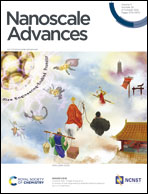Role of cooperative factors in the photocatalytic activity of Ba and Mn doped BiFeO3 nanoparticles†
Abstract
The escalated photocatalytic (PC) efficiency of the visible light absorber Ba-doped BiFe0.95Mn0.05O3 (BFM) nanoparticles (NPs) as compared to BiFeO3 (BFO) NPs is reported for the degradation of the organic pollutants rhodamine B and methyl orange. 1 mol% Ba-doped-BFM NPs degrade both dyes within 60 and 25 minutes under UV + visible illumination, respectively. The Ba and Mn co-doping up to 5 mol% in BFO NPs increases the specific surface area, energy of d–d transitions, and PC efficiency of the BFO NPs. The maximum PC efficiency found in 1 mol% Ba doped BFM NPs is attributed to a cooperative effect of factors like its increased light absorption ability, large surface area, active surface, reduced recombination of charge carriers, and spontaneous polarization to induce charge carrier separation. The 1 mol% Ba and 5 mol% Mn co-incorporation is found to be the optimum dopant concentration for photocatalytic applications. These properties of co-doped BFO NPs can, e.g., be exploited in the field of water splitting.



 Please wait while we load your content...
Please wait while we load your content...